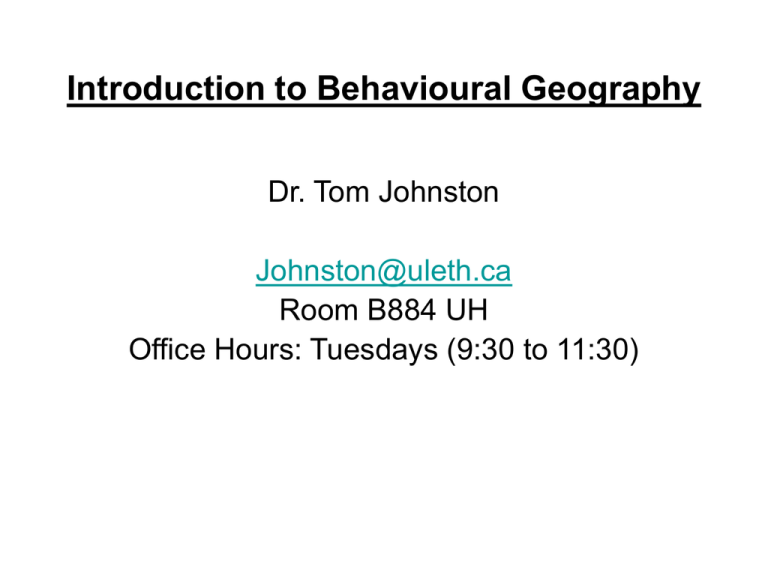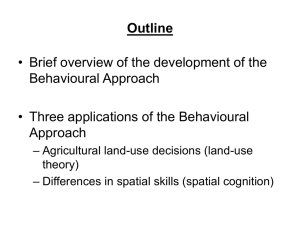Introduction to Behavioural Geography
advertisement

Introduction to Behavioural Geography Dr. Tom Johnston Johnston@uleth.ca Room B884 UH Office Hours: Tuesdays (9:30 to 11:30) What is Behavioural Geography? • An approach to understanding human geographical behaviour • Draws upon research findings in psychology, but also economics, sociology and anthropology. • Focuses on the cognitive processes underlying spatial reasoning, decision making and behaviour. Things that Behavioural Geographers Study – Wayfinding (route selection) – Attachment of Place – Attitudes toward space and place – Locational decisions – Resource allocation decisions Giving Directions ….. From the sixth level of University Hall head toward University Drive. From the University, turn right at the new sign onto University Drive At University Drive, turn north and after about 500 metres, turn east onto Whoop-up Drive Turn right again onto Whoop-up Drive At the top of the hill turn north at the first intersection onto 5th Street Heading north, pass through the 500 and 400 blocks and past the intersection of 5th St. and 4th Ave. The Penny Coffee Shop is located at 331 5th St. At the top of the hill at the fire station, turn left onto 5th Street Go through one intersection – the Mongoli Grill will be on your lefthand side The Penny Coffee Shop is just past the second intersection – kitty-corner to Lethbridge Centre Do Men and Women Tend to Give Directions Differently? Gender Female Male Geo-references Iconic Word Map What do these two examples illustrate or tell us? Outline • Brief overview of the development of the Behavioural Approach • Three applications of the Behavioural Approach – Agricultural land-use decisions (land-use theory) – Differences in spatial skills (spatial cognition) Behavioural Geography: A Brief History • Geography formalized as a discipline in 1874 • Environmental Determinism first “paradigm” to dominate human geography • ED rejected because ….. – Could not be verified empirically – Too many anomalies – Overtly racist (used to justify imperialism) Geography and the Regional Perspective • Following demise of ED, the regional perspective dominated • Regional perspective emphasized detailed study of specific regions, synthesizing knowledge from many systematic disciplines • Emphasized Areal Differentiation According to Richard Hartshorne (1939), the goal of geography was to ……. “provide an orderly and rational description and interpretation of the variable character of the earth’s surface” NB: definition does not include any reference to explanation, prediction, search for laws, or empirical verification. Foundations for the Emergence of the “New” Geography • Regional perspective was not regarded as a science • Edward Ackerman (1945) argued that: – During WWII many regional specialists “lacked the competence in topical and systematic subjects”





